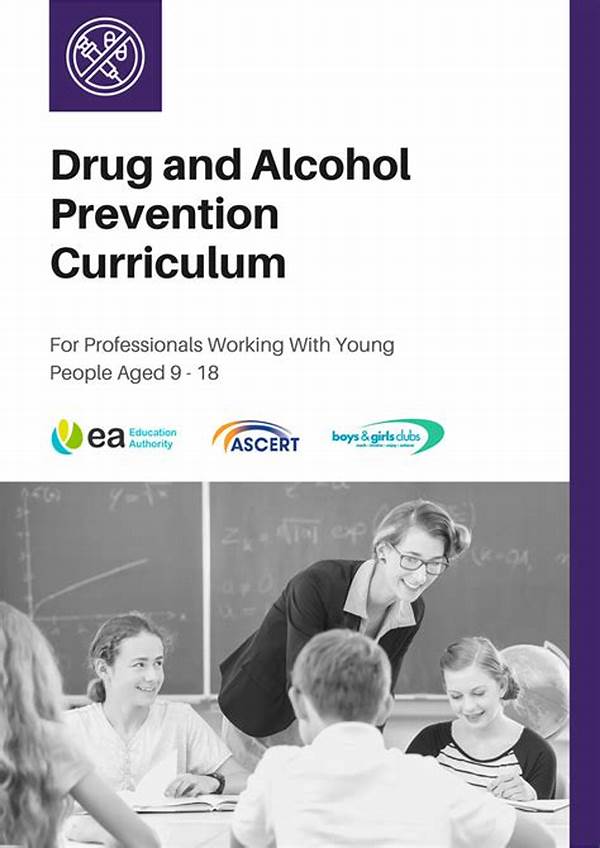
Curriculum Development For Alcohol Prevention
- Daniel Anderson
- 0
- Posted on
Developing a curriculum centered around alcohol prevention is crucial in today’s education landscape. Educators and parents alike recognize the need to tackle the realities of alcohol consumption among teens head-on, creating a nurturing environment that empowers students with knowledge and awareness. As part of this initiative, a well-rounded curriculum can enlighten young minds about the potential consequences of alcohol use while emphasizing healthy lifestyle choices.
Read Now : Non-alcoholic Hangover Remedy Ideas
Designing an Engaging Alcohol Prevention Curriculum
Creating a curriculum for alcohol prevention isn’t just about throwing facts at students – it’s about engaging them on a deeper level. You want to vibe with them, make the lessons stick like glue. Curriculum development for alcohol prevention should be dynamic, incorporating interactive activities, relatable scenarios, and open dialogue. Discussions can be sparked with eye-opening statistics, followed by group activities where students brainstorm healthy alternatives to drinking. Imagine role-playing exercises where students practice saying “no” in a chill yet firm way. To top it off, incorporating stories from individuals who’ve had firsthand experiences with alcohol misuse can make a lasting impact. We’re not just talking lectures here; it’s about sparking a conversation that students want to be a part of, creating a curriculum that speaks their language and makes sense to their world.
Key Elements of Alcohol Prevention Curriculum
1. Relatable Scenarios: Curriculum development for alcohol prevention should use real-life scenarios teens can relate to, making the lessons more impactful.
2. Interactive Activities: Get students involved with hands-on activities that keep their attention and make learning fun.
3. Peer Discussions: Create a safe space for students to share thoughts and experiences, helping them learn from each other.
4. Incorporating Media: Use videos and social media campaigns that resonate with today’s youth, driving home the prevention message.
5. Expert Insights: Bring in experts or testimonials to provide authentic perspectives on the consequences of alcohol misuse.
Empowering Students Through Curriculum
The heart of curriculum development for alcohol prevention beats strongest when students feel empowered. It’s about giving them the tools to make informed choices, rather than just laying down the law. When students are equipped with the knowledge of the effects of alcohol, paired with the skills to navigate social pressures, they build resilience. Curriculum development for alcohol prevention can include teaching coping strategies to manage stress without leaning on a drink. Encourage students to explore hobbies and extracurricular activities that foster a sense of belonging and purpose, creating a supportive community. At the end of the day, it’s about crafting a program that’s not just preventative, but also enriching, shaping students into strong, informed individuals ready to face life’s challenges.
Read Now : Diy Methods To Avoid Hangovers
The Role of Educators in Alcohol Prevention
Educators play a pivotal role in curriculum development for alcohol prevention, acting as mentors and trusted figures. Engaging with students, they set the stage for impactful dialogues about choices and consequences. Educators can guide students through these formative years, promoting a culture of awareness by opening up about the facts and dispelling myths surrounding alcohol use. It’s about building trust and rapport, so students feel comfortable seeking advice when they’re facing tough situations. Being that rock is essential in guiding students through the maze of adolescence, armed with the knowledge that empowers them to steer clear of alcohol.
Engaging Teaching Methods
Utilizing engaging teaching methods is key in curriculum development for alcohol prevention. Think outside the traditional classroom setting; perhaps field trips to community centers that focus on healthy living or virtual tours of rehab centers to offer a stark contrast. Team up with local organizations for workshops that discuss the impacts of alcohol and provide hands-on learning experiences. You want the curriculum to be an eye-opener, right? Dive into multimedia presentations that showcase real stories, encouraging empathy and understanding. Throw in some online quizzes and competitions to reinforce learning and keep students on their toes. The more innovative the approach, the more it sticks with students.
Building Resilience in Students
One of the primary objectives of curriculum development for alcohol prevention is building resilience among students. This involves teaching them how to handle life’s curveballs without turning to alcohol as a crutch. Lessons can incorporate role-playing to simulate real-life situations, allowing students to practice refusal skills. Encourage them to identify support systems in their lives, like friends, family, or school mentors. Introduce mindfulness practices like meditation or yoga to bolster emotional well-being. It’s all about painting a big picture where students see the benefits of a healthy, alcohol-free lifestyle. Strengthening their resolve to make wise choices is the ultimate goal.
Summary of Effective Curriculum Strategies
Developing a successful curriculum for alcohol prevention hinges on innovation and relatability. The program should be crafted with an understanding of the teenage psyche, using language and methods that resonate with their world. Curriculum development for alcohol prevention isn’t just about avoiding alcohol – it’s about embracing life with a holistic approach. Programs should include diverse activities that stress the importance of balance, self-worth, and making choices that promote well-being. It’s not about lecturing but mentoring, guiding students to become informed, resilient individuals. The journey of curriculum development for alcohol prevention is about stepping into the shoes of the youth, ensuring the message hits home, and builds a foundation for lifelong healthy habits.